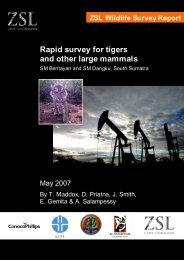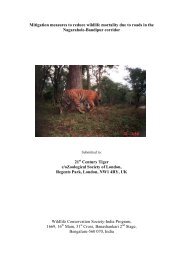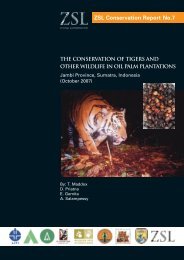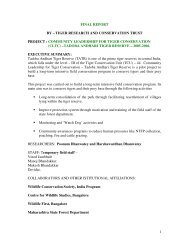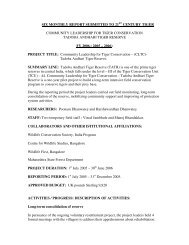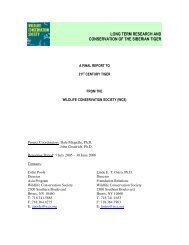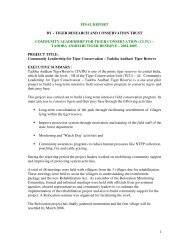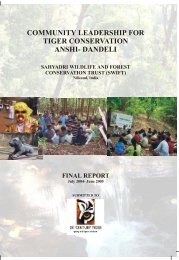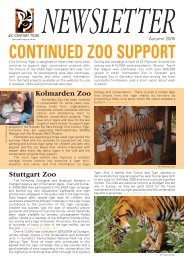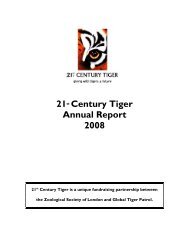Phoenix Fund Final report 2010 - 21st Century Tiger
Phoenix Fund Final report 2010 - 21st Century Tiger
Phoenix Fund Final report 2010 - 21st Century Tiger
Create successful ePaper yourself
Turn your PDF publications into a flip-book with our unique Google optimized e-Paper software.
Amur tiger conservation<br />
in <strong>2010</strong><br />
<strong>Final</strong> <strong>report</strong><br />
January-December <strong>2010</strong><br />
Vladivostok<br />
Russian Far East<br />
<strong>2010</strong>
PROJECT OVERVIEW<br />
The goal of the project is to ensure Amur tiger population survival in Primorsky region,<br />
including:<br />
Saving injured, orphaned or sick wild tigers by providing food, housing and<br />
medical care;<br />
Gaining in support from the local people though ecological education and<br />
outreach activities for children and adults as well as <strong>Tiger</strong> Day festivals in Terney,<br />
Lazo and Kirovka towns.<br />
To ensure long-term survival of Amur<br />
tiger <strong>Phoenix</strong> proposed a program<br />
comprising tiger rescue operations and<br />
educational activities in Primorye,<br />
Russian Far East. Primorye represents the<br />
only area in the world where the<br />
Amur/Siberian tiger still exists in the<br />
wild. The species is listed Endangered by<br />
the IUCN and is on CITES Appendix I for<br />
protection status. Protected under the<br />
Russian and international laws and<br />
regulations, the Amur tiger population is<br />
still threatened by poaching, habitat<br />
destruction, prey depletion and conflicts<br />
with people. Till nowadays the incessant<br />
and insatiable demand for tiger parts in<br />
Landscape in Primorye<br />
the South - East Asia appears to be the main driving force behind poaching and traffic.<br />
© <strong>Phoenix</strong><br />
Official estimates of Amur tiger numbers<br />
in Russia come from full range surveys<br />
conducted only once every 10 years. The<br />
last survey conducted in 2005 revealed<br />
that 431-529 tigers resided in Russia<br />
(compared to the 1995 survey, when 415-<br />
476 tigers were <strong>report</strong>ed). These results<br />
suggested that tiger numbers were stable<br />
during that 10-year period. However, in<br />
October 2009, the Siberian <strong>Tiger</strong><br />
Monitoring Program released results<br />
indicating that Amur tiger numbers were<br />
© <strong>Phoenix</strong> falling in the Russian Far East, primarily<br />
Amur tiger<br />
due to poaching and habitat degradation.<br />
According to their data, there is a 40% decrease. In view of the foregoing, the antipoaching<br />
brigades had to strengthen their efforts to suppress poaching.<br />
In <strong>2010</strong>, <strong>Phoenix</strong> supported anti-poaching efforts in Primorye, keeping in mind that<br />
saving the Amur tiger depends mostly on Russian people, especially those living within<br />
the tiger habitat. This requires involvement of the public, which can be achieved through<br />
continuous ecological education and outreach activities in the region. The main long-term<br />
objective of our education and outreach efforts in Primorsky krai is to reduce poaching,<br />
habitat destruction and human-induced fires in the Amur tiger range. Our main target<br />
2
groups are local villagers and especially schoolchildren, because it is easier to influence<br />
children’s mentality than that of adults. Since 1998 <strong>Phoenix</strong> has been supporting a<br />
number of eco-centres in the region and initiated their creation in some cities.<br />
Experienced educators conduct ecological classes and lectures, give slide presentations<br />
and organize other activities for children and adults.<br />
Below we present our results achieved from January through December <strong>2010</strong> in terms of<br />
the Amur tiger conservation project that combines conservation-oriented ecological<br />
education and outreach activities for children and adults of the region. We are glad to<br />
<strong>report</strong> that the project has met its objectives. Upon completion of the project the<br />
awareness of local people, including children and adults, about the state of Amur tigers<br />
and importance of wildlife and habitat conservation significantly increased. In <strong>2010</strong>, as<br />
many as13,538 children attended 685 eco-lessons, excursions, clean-up actions and other<br />
events. <strong>Phoenix</strong>, according to its proposal, was also responsible for financing stable care<br />
for injured, orphaned or sick wild tigers, however Severtsov’s Ecology and Evolution<br />
Institute of the Russian Academy of Sciences backed by Russian Prime Minister Vladimir<br />
Putin voluntarily covered all costs to rehabilitate tiger cubs and release them back in the<br />
wild.<br />
PROJECT ACTIVITIES<br />
I. Rehabilitation of rescued tigers<br />
The four Amur tigers were rehabilitated during the <strong>report</strong>ed period. We are glad to <strong>report</strong><br />
that the Russian Government, namely Severtsov’s Ecology and Evolution Institute of the<br />
Russian Academy of Sciences, covered the costs of rehabilitation of those tigers. The<br />
Institute is running an Amur tiger research program in the Ussuriisky Nature Reserve and<br />
has a support from Russian Prime Minister Vladimir Putin. Thus, we reserved the funds<br />
allocated by the 21 st <strong>Century</strong> <strong>Tiger</strong> for the second half of the <strong>2010</strong>, in case some financial<br />
assistance from NGOs would be required for medical treatment, care, feeding or<br />
transportation of rescued tigers. Luckily, there were no such cases, and we spent this<br />
amount for additional ecological education and outreach activities in Primorye.<br />
II. Ecological Education and Outreach Activities<br />
Environmental education in the North of Primorye<br />
Education forms an essential component of the conservation programmes of the <strong>Phoenix</strong><br />
<strong>Fund</strong>. The main threats to the survival of the Amur tiger are poaching of the big cats<br />
themselves, poaching of their prey species, illegal logging and very frequent humaninduced<br />
forest fires that reduce both quality and quantity of the habitat. These threats can<br />
be reduced with education as they are directly related to attitudes and behaviour of local<br />
people, and especially of villagers living in forest settlements and small towns in -or close<br />
to- tiger and leopard habitat. The ultimate and long-term objectives of <strong>Phoenix</strong>'s education<br />
projects is to diminish the threats to Amur tigers and their forest habitat.<br />
During the <strong>report</strong>ed period the experienced educators conducted regular classes devoted to<br />
the Amur tiger and other wildlife at local schools. These classes included videos, slide<br />
presentations, lectures, games, quizzes and contests. All in all, as many as 685 ecological<br />
3
events, including lessons, excursions, and contests, were held in three northern districts of<br />
Primorye for 13, 538 children and 786 adults.<br />
a) Eco-classes in Terney<br />
In 2005, <strong>Phoenix</strong> established ties with the<br />
Uragus ecological NGO of Terney town,<br />
led by Galina Maksimova who devoted the<br />
greater of her life to teaching children<br />
Biology and Ecology. Terney is a<br />
strategically important place for tiger<br />
education. Sikhote-Alin Biosphere<br />
Reserve is located in the district. The<br />
Russian-American Amur tiger<br />
conservation project has been running<br />
© <strong>Phoenix</strong> there for 15 years. Since very beginning,<br />
Watching larga seals<br />
Uragus started collaborating with<br />
scientists in education and outreach among<br />
the youth, inviting them to lessons and holidays, such as <strong>Tiger</strong> Day. Schoolchildren take<br />
care of a wonderful garden in the club’s yard, go hiking to picturesque corners and have<br />
visits with performances by their peers from villages, at times very remote ones. A tiger<br />
poster on the wall of Terney school appeals for people to save it.<br />
During the <strong>report</strong>ed period the educator carried out 334 eco-lessons and other events of<br />
the Amur tiger and nature-related topics. All in all, over 5,035 children and 701 adults<br />
attended the events.<br />
In January the educator held 21 classes and an excursion for 115 children aged 6-17.<br />
© <strong>Phoenix</strong><br />
Paper folding craft lesson devoted to Amur tiger<br />
In early January the educator worked to<br />
prepare six children for the regional<br />
Biology competition. Six classes were<br />
devoted to larga seal, also known as<br />
spotted seal (phoca largha). Using fieldguides<br />
and videos the children learned<br />
about sea mammals of the Sea of Japan<br />
and ecological and biological peculiarities<br />
of that group of animals. Then, the<br />
children made a day-long excursion to<br />
Blagodatnoye lodgement of the Sikhote-<br />
Alin Biosphere Nature Reserve where they<br />
watched larga seals on the reefs for several<br />
hours. During two following classes the<br />
pupils were encouraged to express their<br />
feelings towards sea mammals with the help of drawings, photos and modelling. The<br />
children were much excited about the excursion because they had never seen live larga<br />
seals before though they lived at the seaside. On the way back to the reserve they saw<br />
many tracks of ungulates, raccoon dog, and fox in the snow and saw a cormorant, sea<br />
eagle and harlequin ducks.<br />
4
In January, the educator also gave two<br />
classes to the first-graders (7 years old)<br />
explaining how animals and plants live.<br />
In February – March the educator held<br />
21 lessons for 130 children of Terney<br />
town, aged 6-17.<br />
On February 4 and 5, the educator gave a<br />
lesson to two groups of children aged 7<br />
about wild and domestic animals. On<br />
February 6, Galina Maksimova<br />
organized two seminars for high school<br />
students “Driving Forces Behind<br />
Poaching” and “How Is It Going, <strong>Tiger</strong>?”<br />
At the first seminar the participants<br />
© <strong>Phoenix</strong><br />
Children have a good look at posters about tigers<br />
discussed legal and moral aspects of poaching. At the second one they talked about factors<br />
that accounted for the current tiger numbers.<br />
On March 15, the educator gave a lesson “Making Acquaintance with <strong>Tiger</strong>” for pupils of<br />
the first grade (7 years old).<br />
On March 24, there was a conference on comparison of different methods of tiger count in<br />
Terney, and Uragus members were invited to attend it. Despite complicated style of<br />
speakers, they were able to follow the <strong>report</strong>s and even asked questions.<br />
In April the educator and her helpers gave four<br />
classes for 280 children of Serzhantovo school.<br />
First, the children were tested on tiger topics. Then,<br />
they saw a slide presentation about the Russian-<br />
American Amur tiger project in Primorsky region of<br />
Russia and the history of Terney town. The lessons<br />
ended with a theatrical performance about the<br />
Tigress and her cub.<br />
For the middle classes the educator organized a<br />
game-competition “Following <strong>Tiger</strong> Tracks”. For<br />
senior pupils (16-17 years old) she organized a film<br />
screening of “<strong>Tiger</strong>s of the Third Millennium” and<br />
follow-up discussion of it.<br />
On May 16, ten members of Uragus and three<br />
educators went to Serzhantovo village for three days<br />
© <strong>Phoenix</strong> for a meeting with their peers from a local tourist<br />
Clean-up action<br />
club and a discussion of Amur tiger issues. The<br />
hosts showed them a master class on rock climbing and took on an excursion to<br />
Nikolaevsky cave in the vicinity of the town of Dalnegorsk. Heaps of garbage hampered<br />
the participants from admiring the scenery, so they decided spontaneously to clean it. As<br />
they had no space in their bus to take the garbage, they left 20 bags fully laden with<br />
garbage on the roadside in the hope that some conscientious person would bring it to the<br />
dump.<br />
5
In August-November the educator carried out 144 events for 2,176 aged 5 - 18 and 120<br />
adults.<br />
In August-September the teenagers were busy working in Zamanikha arboretum, namely<br />
they killed weeds, replanted young trees, mowed lawns etc to beautify it. Every month at<br />
least 3-5 excursions are organized in the garden for residents of Terneisky district and<br />
guests. Besides, local people, mostly parents with children, visit the arboretum every day.<br />
In August the educator arrange excursions for children around Terney town during which<br />
the kids observed wild animals and plants. On August 24, nine young members of Uragus<br />
participated in an international workshop devoted to research study and conservation of<br />
bears.<br />
In September, the educator conducted regular classes for children of three age groups.<br />
The first group consisted of 23 second-graders who visited the eco-centre for the second<br />
year. The second one was represented by forth-graders who started attend classes in<br />
September <strong>2010</strong>. And the third one was made of 22 children (7-11 grades) who visited the<br />
eco-centre to gain more knowledge in biology or to conduct some research work or<br />
project. Some of them took part in various ecological actions and events.<br />
In October, there were special classes for kindergarten children (drawing, modeling,<br />
application) in the eco-centre. In October Galina Maksimova with support from the<br />
<strong>Phoenix</strong> <strong>Fund</strong> and Wildlife Conservation Society organized <strong>Tiger</strong> Day in Terney. In late<br />
October an intellectual game “What? Where? When?”, a prototype of a TV-game show<br />
well-known in Russia, was held in the eco-centre. During the game the young players<br />
asked questions about historic events, ecological problems, and others.<br />
In November, 14 children from Plastun<br />
village visited the eco-centre and took a<br />
stroll to Lake Blagodatnoye where they<br />
observed swimming birds and learned<br />
historic facts about Terney. Then, they<br />
saw larga seals and visited the<br />
arboretum. After joint games and<br />
lessons, the children from Plastun and<br />
Terney became friends and decided to<br />
meet again in Plastun this time. On 22-<br />
30 November the members of Uragus<br />
participated in regional contests in<br />
biology and ecology.<br />
Meeting with <strong>Tiger</strong> Volodya<br />
© <strong>Phoenix</strong><br />
In December, the educator carried out 40<br />
events for 533 schoolchildren aged 7-17 and 250 adults. The Uragus eco-club members<br />
and Galina Maksimova visited 14 local companies in order to raise adults’ awareness of<br />
ecological issues. During the visits the children recited poetry about wild animals, asked<br />
riddles, performed stunts, told about ecological projects and handed our calendars with<br />
children’s paintings to the audience. From December 20 to December 28 <strong>Tiger</strong> Volodya,<br />
a disguised actor, with a group of children dressed as wild animals walked along Terney<br />
streets, met passers-by and talked about tiger conservation issues. Many people were<br />
pleased to meet the “animals”, took pictures of them and discuss local ecological<br />
problems.<br />
6
) Eco-classes in Lazo<br />
Since 2007 <strong>Phoenix</strong> has been supporting<br />
ecological education in Lazo town. The<br />
specialists of Ecological Education<br />
Department of Lazovsky Nature Reserve<br />
established systematic work with schools,<br />
kindergartens, and people of the district.<br />
Among their innovations are binary<br />
lessons, where teachers of two adjoining<br />
disciplines lead the lesson together.<br />
Educators Galina Dikalyuk and Olga<br />
Degtyarenko developed a large number of<br />
ecological games, holiday scenarios,<br />
training programs for preschoolers and<br />
children of primary school. “Ecological<br />
teams” consisting of teachers and club<br />
© <strong>Phoenix</strong> members are sent to district schools. With<br />
“Amur <strong>Tiger</strong>” lesson<br />
the help of traveling exhibitions,<br />
discussions, theatrical performances, film screenings and games, schoolchildren and<br />
teaching staff of village schools become familiar with ecological issues. Not only<br />
theoretical knowledge is involved; pupils also plant trees, make and set up birdfeeders,<br />
and collect rubbish. There is a Nature Museum at the Reserve, where thematic excursions<br />
are organized.<br />
In <strong>2010</strong>, as many as 7,905 people,<br />
including children and adults, attended<br />
324 ecological events organized by the<br />
specialists of the Lazovsky Nature<br />
Reserve.<br />
For comparison, in 2009, there were 314<br />
ecological events with 7,988 participants.<br />
Thematic excursions to the Reserve’s<br />
Nature Museum were popular in <strong>2010</strong>.<br />
All in all, the educators organized 310<br />
excursions for 2,919 visitors. During the<br />
Year of the <strong>Tiger</strong> the educators elaborated<br />
and gave lessons devoted to tiger, namely<br />
“Amur <strong>Tiger</strong>”, “Cats of Our Forest”,<br />
“Following <strong>Tiger</strong> Tracks”, and “<strong>Tiger</strong>s of<br />
Our District”, etc. For adults there was a<br />
number of events, including a quiz “What<br />
Do I Know about Amur <strong>Tiger</strong>?”, meetings and discussions of Amur tiger conservation<br />
issues.<br />
Below, we represent description of ecological education activities from January through<br />
December <strong>2010</strong>.<br />
In January, the educators gave 13 eco-classes for 268 children.<br />
© <strong>Phoenix</strong><br />
“Animals Are Roaming in the Forest” lesson<br />
7
© <strong>Phoenix</strong><br />
“Distinguished Specialists of Nature Reserves” lesson<br />
feeders.<br />
On January 15 and 22, the specialists of<br />
Ecological Education Department of<br />
Lazovsky Nature Reserve carried out an<br />
ecological class “Feed Birds” for 39 firstgraders<br />
to familiarize the children with<br />
wintering birds of the region and tell<br />
about methods used to help birds survive<br />
through the winter. During the lesson the<br />
children learned to determine bullfinch,<br />
redpoll, waxwing, tomtit, nutcracker and<br />
others, understood relation between bird<br />
food supply and starting time for<br />
migration, learned how to make bird<br />
feeders and types of bird food. Some of<br />
the children could identify bird species<br />
that frequently visited their backyard bird<br />
On January 11 and 18, thirty-one kindergarten children attended a lesson “Amur <strong>Tiger</strong>”.<br />
The teachers told about Red Data Book and rules of human behavior in the forest. Most of<br />
all the children liked playing a game “A <strong>Tiger</strong> and a Hunter”.<br />
On January 12 and 22, the educators<br />
visited a local kindergarten to conduct a<br />
lesson “Cats of Our Forest” for 28<br />
children aged 5-6 to familiarize the kids<br />
with tigers, leopards, lynxes and explain<br />
the notion of Red Data Book.<br />
On January 14, the educators visited a<br />
local kindergarten and gave a lesson<br />
“<strong>Tiger</strong>s and Leopards” for 71 children<br />
aged 4-6 to show the beauty and dexterity<br />
of wild cats. The children were divided<br />
into two groups “<strong>Tiger</strong>s” and “Leopards”<br />
to compete in various tasks. They jumped<br />
as wild cats, 'hunted' prey species, and<br />
followed cat tracks, etc. During the breaks<br />
between tasks they read poems and sang<br />
song about tigers and leopards.<br />
“Deer and <strong>Tiger</strong>” game<br />
In February, the educators held 26 events for 812 children 5-17 years old.<br />
© <strong>Phoenix</strong><br />
On February 1, the educators gave a lesson on biodiversity for twenty-six children. They<br />
visited Nature Museum of the Lazovsky Nature Reserve, watched video episodes from<br />
life of various animals and answered the educator’s questions. On February 15, the<br />
educators showed a slide presentation “Let’s Feed Birds” for 14 children.<br />
8
© <strong>Phoenix</strong><br />
Eco-lesson for kindergarten children<br />
villages of Lazovsky district.<br />
On February 19, the educator with the ecoclub<br />
members organized a mini-quiz<br />
“What Do I Know about Amur <strong>Tiger</strong>?” for<br />
160 children and adults of Lazo town.<br />
They stopped people in the streets to ask<br />
them some questions. The respondents<br />
showed good knowledge on the current<br />
state of Amur tiger, but were surprised to<br />
know some facts, e.g. that many young<br />
tigers died before reaching adult age, that<br />
tiger density was low in the reserve etc.<br />
In March, the specialists of Lazovsky<br />
Nature Reserve gave 38 lessons for 942<br />
children aged 4-14 from kindergartens and<br />
secondary schools of Lazo town and<br />
On March 23, twelve children attended a lesson “Who Woke up in the Forest?”, at which<br />
they broadened their knowledge on life of wild animals, especially on their behaviour in<br />
spring. They discussed magpies, crows, bears and tigers, learned which animals went into<br />
hibernation and which not.<br />
On March 25, the educators gave a lesson “Spring in the Forest” for twelve children.<br />
During the lesson the children guessed riddles about animals, described first spring<br />
flowers, reasoned why it was not good to pick them and to ruin birds’ nests.<br />
On March 10, twenty-four children participated in a lesson “Protected Areas of Russia”,<br />
in the course of which they got general information about nature reserves, learned in more<br />
detail about local ones, and compared nature reserves and national parks.<br />
On March 15, 17, 18 and 19, the<br />
educators gave a series of lessons<br />
“Following <strong>Tiger</strong> Path” for 154 children.<br />
First, they told them about tiger<br />
characteristics, habitat and density, then<br />
about organizations that worked to protect<br />
tigers. At the end of the lesson the<br />
children played a game, the winner of<br />
which had a right to make a phone call<br />
“to a tiger”.<br />
On March 18 and 26, the educator<br />
showed a slide presentation “<strong>Tiger</strong>s of<br />
Our District” and held a discussion with<br />
102 children. She spoke about methods<br />
used to study tigers in Lazovsky Nature<br />
Reserve, showed pictures made by<br />
Visit to Reserve’s Nature Museum<br />
© <strong>Phoenix</strong><br />
photo-traps and discussed numerous factors that influenced tiger numbers. On March 19,<br />
sixteen children had a lesson “Visit to a <strong>Tiger</strong>”, at which 16 children participated. The main<br />
character – a tiger cub – told about his life, his mother, and neighbors.<br />
9
In April the educators held 25 classes for 632 pupils 4-17 years old. On April 15, they<br />
gave a lesson on first spring flowers for 13 kindergarten children, during which they<br />
guesses riddles, described a picture of a fading flower, learned why it was bad to pick up<br />
wild flowers, used images of dandelions and of a meadow to “make” a flowered and<br />
flowerless landscapes and told kind words to the flowers.<br />
On April 23, twenty-five children attended a lesson “How Do Trees Wake Up?”, at which<br />
they learned such notions as flow of sap and played a game “Me, a tree” on imitation of<br />
changes in trees in spring. On April 5 and 7, the educator gave a lesson on first spring<br />
flowers for 38 children.<br />
On April 21 and 26, the educator showed a slide presentation “Safety in the Forest” to 32<br />
children. They learned what to do in case of a snakes or insects bite, fire, loss of<br />
orientation, and encounters with predators. The educator explained to them how to<br />
minimize risks in those situations. The children shared their own experience. On April 16<br />
and 23, the educator gave a lesson on the protected areas of Primorye, in the course of<br />
which they played a game “Animals – Man”, dramatized the history of relationship<br />
between animals and men and came to a conclusion about the important role of nature<br />
reserves.<br />
In May, the educators held 11 classes for 742 pupils 5-16 years old. On May 18, the<br />
educator gave a lesson “Why Lives on Our Territory?”, the purpose of which was to<br />
acquaint the children with different living organisms and show their interconnection with<br />
the surrounding world, to foster careful attitude, respect and care about nature. In May,<br />
two groups of the eco-club planted 1,200 Korean pine seedlings around the Nature<br />
Reserve and removed garbage from the recreation area in Lazo.<br />
In June, the educators conducted 9 classes<br />
for 238 pupils 7-10 years old.<br />
On June 7, a lesson on the Indian marten<br />
gathered 54 children. They watched a film<br />
on that animal, searched for it and its<br />
relatives in the Nature Museum of the<br />
Lazovsky Nature Reserve, and described<br />
the animals with their own words.<br />
On June 18, the educator gave a lesson on<br />
sable. The participants watched a video<br />
“13 minutes from a sable life”, took part<br />
in a quiz “Recognize me” and studied<br />
food chains (what animals ate).<br />
On June 21, the educator gave a lesson on<br />
plants, which represented a competition of<br />
© <strong>Phoenix</strong><br />
Planting Korean pine in the vicinity<br />
of Lazovsky Nature Reserve<br />
four teams. The pupils tried to recognize a certain tree with their eyes shut, corrected<br />
mistakes in the information on some trees, worked a crossword puzzle, named as many<br />
leaved/coniferous trees as they knew, and searched live trees outdoors taking their<br />
herbaria as an example.<br />
10
On June 28, the educators conducted a<br />
game “All about Him”, the purpose of<br />
which was to enlarge the<br />
schoochildren’s knowledge on the Amur<br />
tiger. Different tasks were prepared,<br />
related to mathematics, geography,<br />
ethnology, cookery and rules of<br />
behavior in the forest.<br />
On June 23-25, the educators of the<br />
Lazovsky Nature Rereseve hosted a<br />
seminar for educators of the Lazovsky<br />
district, devoted to succession in<br />
ecological education between<br />
© <strong>Phoenix</strong><br />
During a lesson about tigers<br />
kindergartens and secondary schools.<br />
Twenty teachers took part in it. The<br />
participants worked to find a way to avoid a gap between those two stages, discussed how<br />
to make the process coherent and not sporadic, watched films that could be used at the<br />
lessons and presented their self-written ecological fairy-tales in groups.<br />
In September, the educators organized 23 ecological events for 501 people in Lazovsky<br />
district.<br />
On September 9 and 16, the educators<br />
gave a lesson Science About Life,<br />
Science For Life the main objectives of<br />
which were to refresh and solidify<br />
children's knowledge of Ecology,<br />
stimulate logical thinking and analysis<br />
of information, increase the level of<br />
ecological culture and responsibility for<br />
the environment state. During the lesson<br />
the children were asked to answer the<br />
following questions: What is Ecology?,<br />
Why do we need Ecology?, What role<br />
does human play in the environment?<br />
What is Ecology consisted of? What<br />
other sciences is Ecology connected<br />
with?<br />
© <strong>Phoenix</strong><br />
Kindergarten children study forest products<br />
On September 13, over twenty-one seventh-graders attended a lesson focused on<br />
ecological laws. The lesson was given to familiarize the children with such notions as<br />
ecological laws and their principals, system of ecological laws in Russia and basic<br />
international ecological regulations. Also, the pupils learned about punishment for<br />
ecological violations. The theme turned out to be of big interest to the children. On<br />
September 13 and 19 the educators gave a Man's Nature lesson for 31 pupils of the 8 th<br />
grade. During the lesson the children discussed the following questions: Do you believe<br />
that man originated from ape? What is man's nature? Does man depend on the rules of<br />
ecology completely? What are differences and similarity between man and animals? What<br />
changes have occurred in relations between man and nature during human evolution? Is<br />
man continue evolving now?<br />
11
On September 24, about twenty-three fifth-graders attended an “Introductory to Ecology”<br />
lesson. The main objectives of the lesson were to give basic knowledge about Ecology,<br />
explain notions such as ecosystem and ecological issues, inform about the difference<br />
between local and global ecological issues, and promote formation of ecological culture<br />
by explaining the role of human in nature conservation. Lazovsky district was taken as an<br />
example, and the children discussed local ecological issues, ways to solve the problems<br />
and level of children's involvement in their solution. Then, they solidify the obtained<br />
knowledge through playing an active ball game. The teacher was glad to notice that the<br />
children displayed a keen interest in studying Ecology and expressed their willingness to<br />
help solve local ecological issues.<br />
On September 28, the teacher conducted a lesson for twenty-one schoolchildren to<br />
increase their knowledge about professions in protected areas. During the lesson the<br />
teachers told about goals and objectives of the protected areas system in Russia, showed<br />
video and photo-materials illustrating professional activities by specialists of protected<br />
areas.<br />
In October, the educators organized nine<br />
ecological lessons for 159 children aged<br />
4-10. On October 21 and 25 as many as<br />
forty children of elementary school<br />
attended a lesson “How Do Wild<br />
Animals Prepare for Winter?” The main<br />
objective of the lesson was to familiarize<br />
the kids with various ways the animals<br />
use to prepare for winter. During the<br />
lesson the children learned about<br />
migratory and wintering birds,<br />
hibernating animals and other forest<br />
dwellers.<br />
© <strong>Phoenix</strong> On October 13 and 22, the educator<br />
Who is the Master of Taiga?<br />
gave a lesson “We Are Different” for<br />
forty-one second-graders with the purpose to show the children diversity of creatures on<br />
the example of forest dwellers. During the lesson the children played a game and learned<br />
similarities and differences among animals.<br />
On October 15 eighteen children aged 9-10 attended a lesson “Who Is the Master of<br />
Taiga?” The main goal of the lesson was to inform about the forest ecosystem and explain<br />
its interconnections.<br />
On October 4 and 11, the educator delivered a lesson “A Trip of Fruits and Seeds” for 30<br />
kindergarten children. In the beginning of the lesson a <strong>Tiger</strong> Cub (disguised teenager)<br />
entered the class and asked the children to explain why so many new plants appeared on<br />
his favorite clearing. Then, the children and the educator study what seeds can travel by<br />
air or in birds' stomach, or hanging on animals' fur and man's clothing, etc.<br />
On October 5, thirteen kindergarten children attended a lesson “Forest Apartments”.<br />
During the lesson the children learned where animals live: nest, burrow, hole, den etc. and<br />
that their houses can be on or under the ground. A <strong>Tiger</strong> Cub (disguised teenager) took<br />
the children in the forest and gave the right names of animals' houses.<br />
In November, the educators carried out 31 ecological events for 529 children aged 5-18.<br />
12
On November 1, twenty-five kindergarten children attended a lesson “Birds Are Our<br />
Friends” during which they learned to care about birds. First, the teacher read a text about<br />
benefits of birds. Then, the children were asked to imitate birds and show what birds<br />
usually do in their gardens. The teacher explained them why birds need bird feeders in<br />
winter and gave examples of setting bird feeders in one's yard.<br />
On November 2, the educator gave a<br />
lesson “Wintering Birds of Our Forest”.<br />
Twelve six-year children attended the<br />
lesson and gained knowledge about<br />
wintering birds and ways to help them<br />
survive the winter. During the lesson the<br />
children guessed riddles, read verses<br />
and viewed photos of birds. Comparing<br />
literary description and photos of birds,<br />
they noted some distinctive features:<br />
ways of traveling, feeding habits and<br />
appearance. The teachers explained the<br />
reasons of bird migration to the young<br />
pupils. Then, the children were taught<br />
how to set a bird feeder in one's yard<br />
and “golden rules of bird feeding”. The<br />
© <strong>Phoenix</strong><br />
Birds Are Our Friends lesson<br />
teacher assigned the children to make a<br />
bird feeder for homework. On the same<br />
day a lesson “Northern Jungle” was given to 90 pupils of 4-11 grades. During the lesson<br />
the children continued getting acquainted with the Ussuri taiga and studying life of rare<br />
animals of Lazovsky Nature Reserve on the example of Indian Martin. The same lesson<br />
was also given on November 18.<br />
On November 19, a lesson “Who Lives Where?” was given to 18 first-graders to give an<br />
idea of wild animal habitat. During the lesson the teacher discussed with the children a<br />
diversity of human dwellings and dependence of animals' habitat on their lifestyle, played<br />
a game “Find Your Home!” and put animals in “forest apartments”. The first-graders<br />
learned the lesson fast.<br />
A Wild Zoo game<br />
© <strong>Phoenix</strong><br />
On November 10 and 18 the educators<br />
gave two lessons “<strong>Tiger</strong>'s Arithmetic” in<br />
the course of which forty-four secondgraders<br />
learned the main features of the<br />
Amur tiger. The main objective of the<br />
lessons was to foster friendly and<br />
respectful attitude towards wild animals.<br />
On 23-24 November, thirty-six 3<br />
13<br />
rd -<br />
graders attended a lesson “Invisible<br />
Nature's Threads”. During the lesson the<br />
educators defined food web and energy<br />
pyramid and showed interactions in<br />
forest community. The children learned<br />
that all living things in the forests are
connected with strong but invisible threads – food webs. Also, the children played a game<br />
“Who Am I?” during which they learned the differences between plants and animals in<br />
the food habits. On November 12 and 17, the educators gave a lesson about ecosystem to<br />
39 four-graders. During the lesson the children defined ecosystem and learned about<br />
interactions of living things in the ecosystem. At the end of the lesson they played three<br />
games: “A Wild Zoo, Food Web” and “Earth's Gifts”.<br />
On November 16-17, 23, 26, 29-30 as many as 73 students attended a lesson “My<br />
Totem”. The objective of the lesson was to familiarize the young people with traditions of<br />
indigenous people of Primorye, define totemism and expand knowledge on biodiversity of<br />
Lazovsky Nature Reserve.<br />
On November 19, thirty-three 7<br />
© <strong>Phoenix</strong><br />
A lesson for kindergarten children<br />
th -<br />
graders attended a lesson “Predators and<br />
Their Prey. Friends, Enemies, Partners,<br />
etc.” The objective of the lesson was to<br />
carry on studying food chains. On<br />
November 22, a special lesson devoted<br />
to ecological problems and disasters<br />
was given to 19 pupils of the 9 th grade.<br />
The main goals of the lesson were as<br />
follows: to differentiate ecological<br />
problems and ecological disasters, to<br />
define local and global, to draw<br />
parallels between specific disasters and<br />
ecological problems that triggered those<br />
collapses, to predict possible ecological<br />
disasters in Lazovsky Nature Reserve<br />
taking into account the existing ecological issues. The children turned out very competent<br />
in their role of “experts”. They could name the most urgent ecological problems in their<br />
district and describe colorfully the aftermath. Also, the children offered uncommon, and<br />
even radical, ways of their solution. They emphasized that not only local authority and<br />
environmental law enforcement agency but also ordinary people are responsible for<br />
timely solution of the ecological issues. On the same day the educators gave a lesson<br />
“Biodiversity of Lazovsky Nature Reserve” to 19 pupils of 8 th grade with the main object<br />
to expand their knowledge about biodiversity.<br />
On November 26, the children conducted an excursion for their classmates in the<br />
Reserve's Nature Museum and told about rare animals and plants of the Lazovsky Nature<br />
Reserve. On November 30, a binary lesson Ecology Basics was given to ten 7 th -graders.<br />
During the lesson the children defined biocenosis, biogeocenosis, biome, biotope,<br />
ecosystem, food web, and ecological pyramid.<br />
In December, the educators organized 15 events for schoolchildren aged 5-7 4 lessons for<br />
kindergarten children and two meetings with adults<br />
On December 6 and 13, twenty-nine children aged 6 attended a lesson “Chains in Forest”.<br />
The main objective of the lesson was to explain the young children interaction between<br />
plants and animals. The teacher provided pictures of wild animals and plants so that the<br />
children could listen to her lecture and make chains between forest dwellers. The kids<br />
were asked to explain what could happen if one chain link disappeared. In the end of the<br />
14
lesson they played a game “An Owl and an Old Man” which helped develop better<br />
understanding of interactions between human and wildlife.<br />
On December 7, the educators conducted a lesson “How Have Animals Prepared for<br />
Winter?” for 13 children aged 5 in order to demonstrate how wild animals adapt to winter<br />
conditions and inform about difficulties animals face in forest in winter. During the lesson<br />
the children discussed why some animals hibernate and others stay active throughout the<br />
winter. Then, they played a game during which the teacher asked questions to check for<br />
comprehension. On the same day, twenty 1 st -graders attended a lesson “Who Lives<br />
Where?” and learned about natural habitat of wild animals. The educator explained the<br />
children that animal’s habitat depends on animal’s lifestyle.<br />
On December 8, sixteen 4-year-old children attended a lesson “Winter Has Come” during<br />
which the educator told about winter as the most unfavourable season for wild plants and<br />
animals. The lessons began with a theatrical performance about a tiger cub. The Cub (a<br />
disguised adult) came into classroom and told about his life. He shared his concerns that<br />
he could not recognize his favourite clearing because it became white without insects and<br />
birds and asked the children to explain the reasons of such transformation. And the kids<br />
were happy to tell the Cub everything they knew about winter.<br />
On December 8 and 16, forty-two 2 nd -graders attended a lesson about coniferous trees.<br />
The main objective of the lesson was to familiarize the children with basic coniferous<br />
trees growing in Primorye, touch upon an issue of unabated cutting fir-trees before<br />
Christmas and give ideas of alternative New Year’s decorations. On December 9, 13 and<br />
21, seventy-two people, including senior schoolchildren, students and adults, attended a<br />
lecture devoted to ecology and health. During the lecture the audience watched a<br />
PowerPoint presentation and discussed the following questions: How Are Medicine and<br />
Ecology Are Interconnected? What Is Health? What Ecological Problems Do Impact<br />
Human Health? etc.<br />
© <strong>Phoenix</strong><br />
Excursion in Reserve’s Nature Museum<br />
On December 11 and 22, the educator<br />
gave a lesson “Methods of Surveying<br />
<strong>Tiger</strong>s” for 36 pupils of 4 th -grade.<br />
During the lesson the educator told<br />
about main tiger features and informed<br />
about methods used in Lazovsky Nature<br />
Reserve to study tigers. The teacher was<br />
glad to notice that the children were<br />
aware of the tiger features.<br />
On December 14 and 23, a lesson about<br />
trees was given to thirty-nine 1 st -graders<br />
in order to increase their knowledge<br />
about parts of tree and explain the<br />
differences between deciduous and<br />
coniferous trees. During the lesson the<br />
children played two games: Name a Tree and Make a Tree, discussed functions of tree,<br />
and studied slices of tree stumps.<br />
On December 15, 21 and 22, the educator gave a lesson for 62 junior schoolchildren in<br />
order to expand their knowledge about interactions between plants and animals. The<br />
15
lesson began with a PowerPoint presentation about oak and Korean pine which reflected<br />
interactions between plants and animals and their important role in ecosystem. Then, the<br />
children did crossword puzzles.<br />
On December 11, a lesson “Biosphere” was conducted for 21 pupils of 10 th -grade. During<br />
the lesson the children watched a PowerPoint presentation, learned how the biosphere is<br />
organized and its components, and determined a role of human in biosphere. On<br />
December 15, as many as 87 pupils from 5 th -10 th -grades attended a lesson Forest People.<br />
The main objective of the lesson was to get the schoolchildren acquainted with culture,<br />
beliefs, and traditions of indigenous people in Primorye and explain their attitude towards<br />
nature. After listening to the teacher, the attendees expressed their will to learn to treat<br />
nature as tribal people do.<br />
On December 21, eight adults gathered to listen to a lecture about Lazovsky Nature<br />
Reserve, its history, natural resources and conservation methods. On December 22, the<br />
educators organized a theatrical performance for 158 junior schoolchildren in order to<br />
thank them for their concern about nature and wiliness to conserve rich biodiversity of<br />
their district.<br />
c) Eco-classes in Kirovka<br />
Since 2007 <strong>Phoenix</strong> has been supporting the educational activity of Galina Goy, a teacher<br />
from technical school No. 55 in Kirovsky town. Students of 16-17 years old visit the<br />
Ussury Eco-club, where under the teacher’s guidance, elaborate lessons about the nature<br />
of the Primorsky region are created and presented for school and kindergarten children of<br />
the town. Such method enables them to accomplish two goals: organize teenagers’ leisure<br />
and foster respect and love for nature. Schoolchildren are more receptive to information<br />
delivered to them by people a little older than themselves. In addition to lessons, students<br />
are involved in practical work: they clean their town, plant trees and feed birds in winter.<br />
© <strong>Phoenix</strong><br />
Galina Goy gives eco-lesson in local kindergarten<br />
her and invite to give lessons.<br />
All in all, 598 children and 85 adults<br />
attended 27 lessons and other educational<br />
events organized by the teacher and<br />
members of the Ussury eco-club, secondyear<br />
students. In comparison with the<br />
previous year, it is a good indicator of<br />
results. In 2009, the educator held 24<br />
events of different kind, in which 409<br />
children and teenagers (aged 5-19)<br />
participated. It is worth noting that when<br />
Galina Goy started working in 2007, she<br />
visited local kindergarten and schools and<br />
asked to allow her to conduct lessons<br />
about tiger and other animals. Now,<br />
Galina proudly <strong>report</strong>s that<br />
kindergarteners and schoolteachers call<br />
In January, the educator held three classes for 55 children aged 4-11 and six adults<br />
(teachers). On January 22, the educator gave a lesson “Meeting with Wild Animals of the<br />
16
Ussuriskaya Taiga” for 39 children aged 4-6. The purpose of the lesson was to acquaint<br />
the children with inhabitants of the Ussuri taiga, their role in the eco-system, factors that<br />
regulate their density and peculiarities, especially those of tigers and leopards. Senior<br />
students of Kirovka technical school, who are active members of the Ussury Eco-club,<br />
helped the teacher during the lesson.<br />
First, the children guessed riddles about animals, and if somebody guessed right, he/she<br />
was to tell a few words about the animal. Then, everybody played a game “Spidery Lace”<br />
about interconnections between animals. For example, a squirrel collecting nuts and<br />
acorns dropped some of them, which later grew up, became trees and fed other animals.<br />
The children understood the idea well and gave a detailed answer to the teacher’s question<br />
“What will happen to wild animals if Korean pine was cut out completely”?<br />
On January 27, the educator gave two lessons “Flora and Fauna of the Primorsky Region”<br />
for 16 children 10-11 years old. The third-graders of Kirovka secondary school come<br />
often to the eco-club. First, they watched short videos on nature reserves of Primorye,<br />
after which played a game “Wheel of Fortune” with questions on animals and plants.<br />
In February, the educator held two classed for 31 children 10-16 years old. On February<br />
12, she gave a lesson “Primorsky Region Is My Native Home”, in which 14 children 10-<br />
11 years old took part. At the lesson they learned about the first explorers of the region,<br />
typical local animals and birds, and played a “zoological lotto” game. It consisted of such<br />
questions as “Which animal of the Ussuri taiga is the biggest feline?” etc.<br />
On February 26, seventeen children 15-16 years old attended a lesson “Hard Times for<br />
Wild Animals”. They spoke about winter conditions and the thin crust of ice over snow,<br />
which made it hard for ungulates (and also birds who fly little, such as pheasant) to walk,<br />
and sometimes hurt their feet. This theme was chosen because some time before all local<br />
TV channels showed <strong>report</strong>ings about difficulties wild animals faced. On the educator’s<br />
question how people could help them, the pupils gave such suggestions: to create teams to<br />
make feeding grounds in the forest, to clear roads with vehicles and others. In the course<br />
of the discussion the educator concluded that the children cared much about wild animals<br />
and were interested in helping them.<br />
In March, the educator held two ecological<br />
lessons for 40 children aged 5-11 year-old<br />
and four teachers. On March 17, the<br />
educator conducted an eco-lesson for 13<br />
children of Kirovka secondary school. The<br />
purpose of the class was to continue to<br />
make the children acquainted with wild<br />
animals of the Ussuri taiga, to develop a<br />
sense of responsibility for the living<br />
creatures and the nature. These children<br />
did not come to the eco-centre for the first<br />
time; they do like to be engaged in ecocentre’s<br />
activities. The children<br />
themselves suggested to carry out a lesson<br />
in a form of a game called “Miracle<br />
Field”. In the beginning of the class the<br />
children watched a film “Who Is the<br />
© <strong>Phoenix</strong><br />
“Primorsky Region Is My Native Home” lesson<br />
17
Master in Taiga?” and then answered questions and solved riddles about tiger, its habitat<br />
and other dwellers of Primorsky forests. Then, they played another game called<br />
“Dominoes”. As a result, the lesson lasted longer than it was supposed to as the children<br />
enjoyed playing and learning new facts about the Amur tiger and other wild animals.<br />
On March 25, the lesson “Protect Forest from Fire” was held for 37 kindergarten children.<br />
The goal of the class was to teach the children the fire safety rules, identify main causes<br />
of forest fires and its impact on wildlife. The members of ecological centre started the<br />
lesson with a quiz game. The preschoolers were divided into two teams that had to guess<br />
various riddles about nature. A card with a letter was given for each correct answer and<br />
when all the riddles were solved the children lined up and formed a phrase “FOREST<br />
FIRE”. Thereupon the educator asked questions regarding fire safety rules and the<br />
children showed satisfactory awareness. At the end of the class the most active<br />
participants were awarded with small prizes. The children from senior and preparatory<br />
groups handed their tiger drawings and craftworks over to the eco-centre members for a<br />
forthcoming exhibition “Long Live the <strong>Tiger</strong>” that was to be in May <strong>2010</strong>.<br />
In April, the educator held two classes for 23 children aged 10-12. On April 7, the<br />
educator gave a lesson “Enemies and Friends of the Amur tiger” for 12 children aged 10-<br />
11. The purpose of the lesson was to acquaint the children with factors, that limit tiger<br />
numbers (enemies) and the system of tiger protection (friends); and to foster in children a<br />
sense of responsibility for nature.<br />
The educator led the lesson with several senior members of the Kirovka eco-club. First<br />
she gave a short lecture on factors that ruined nature and disturbed forest inhabitants.<br />
Then she suggested each children describing some animal on their choice: how it reacted<br />
to danger, in what way changed in different seasons etc. They tried to explain how a tiger<br />
behaved when it felt a danger. Then each pupil in turn spoke about one of the tiger<br />
enemies, and ways to help tigers survive.<br />
© <strong>Phoenix</strong><br />
On April 21, the educator gave a lesson<br />
“The biggest feline on Earth” for 11<br />
children 11-12 years old of Kirovka<br />
secondary school. The purpose of the<br />
lesson was to summarize and widen<br />
children’s knowledge on the Amur tiger.<br />
As it was not the first time for the children<br />
to come to the eco-centre, the educator<br />
prepared more difficult questions for them<br />
about tigers and their habitat. The lesson<br />
was organized as a game “Wheel of<br />
Fortune”. All the participants were<br />
involved in it.<br />
Eco-forum in Kirovka, May <strong>2010</strong><br />
In May, the educator held 2 ecological<br />
events for 47 children aged 10-12. On<br />
May 19, she organized an ecological forum “Earth is our home” for 35 children 10-12<br />
years old of the secondary school of Kirovka town. The pupils presented their <strong>report</strong>s on<br />
different animals and plants, and about their project on planting lotus in Lebedinoye lake.<br />
The educator Galina Goy told them about the Amur tiger and Amur lepard that live in our<br />
region, and why it was hard for them to survive. At the end of the lesson the pupils took<br />
18
part in a quiz “Proper behavior in the forest” that contained questions on how to start a<br />
campfire, what to do in case of a forest fire and encounters with wild animals, especially a<br />
tiger. The most active and well-informed children were awarded achievement certificates.<br />
© <strong>Phoenix</strong><br />
Members of Ussury eco-club give a lesson for junior<br />
schoolchildren<br />
On May 27, the educator delivered a<br />
lesson “Where do forest dwellers hide?”<br />
for 12 children of “Ussuri” eco-club in<br />
Kirovka town. They got to know how<br />
wild animals chose a right place for<br />
them to live. Among the questions<br />
discussed there were the following:<br />
Where does the Amur tiger live? Why<br />
do Amur leopards live only in the south<br />
of the region? Why can starlings live in<br />
birdhouses, while swallows prefer to<br />
make houses of clay? Why do some<br />
animals live outdoors, while the others<br />
live in dens or holes?<br />
In June, the educator gave two classes<br />
for 53 children 10-12 years old. On June 19, there was a lesson “Forest mosaic”, aimed at<br />
acquainting children with such animals as Amur tiger, Amur leopard and other local<br />
species, and to develop in children skills of collective work. The lesson consisted of two<br />
parts: a quiz “Forest experts” and a game “<strong>Tiger</strong>s – leopards”. One of the teams was<br />
tigers, the other was leopards. They found similarities and differences of those animals,<br />
showed how they hunted, imitated their voice and describe where they lived. The winning<br />
team got small presents: bookmarks and pocket calendars.<br />
On June 23, the educator led a lesson<br />
“Clean air – our health”. The idea of it<br />
was to detemine the children’s<br />
knowledge on the environment, namely<br />
on the air and water, to foster a sense of<br />
personal responsibility for<br />
environmental protection, and to<br />
develop the ability to analyze, that is, to<br />
find links between human actions and<br />
what happened around in nature. The<br />
educator chose the theme on purpose,<br />
as practically all the children heard<br />
about the problem of air and water<br />
pollution. To start a discussion she<br />
asked a few questions, such as: Why<br />
does air gets dirty? Why does fish<br />
A lesson for kindergarten children<br />
© <strong>Phoenix</strong><br />
sometimes die in the rivers? etc. The children named reasons for pollution. The lesson<br />
continued with outdoors games “Guess who I am”, “Chasing prey”, and steeplechase. At<br />
the end of the lesson the educator asked the participants what should be done to breathe<br />
clean air, and the children gave their opinions, such as “remove garbage after themselves,<br />
not to cut tress and, which is even better, plant new ones, to feed birds” etc.<br />
19
In September, the educator was responsible for organization of two ecological events in<br />
Kirovsky village.<br />
On September 18, Galina Goy with her<br />
colleagues organized <strong>Tiger</strong> Day<br />
celebration in Kirovksy.<br />
On September 28, the educator gathered<br />
48 young people aged 16-19 to<br />
participate in sports competitions. The<br />
idea of the event was to promote healthy<br />
lifestyle and make it clear that fresh and<br />
clean air means healthy mankind and<br />
planet. The boys and girls participated<br />
in the 3,000-meter dash and 1,000-meter<br />
Children read a leaflet about tiger<br />
© <strong>Phoenix</strong> dash, respectively. Then, they<br />
participated in long jump and put the<br />
shot. During the competitions the young<br />
people saw that only those who go in for sports, live without smoking and drinking<br />
alcohol, can be winners.<br />
In October, the educator conducted two<br />
lessons for 40 kindergarten children. On<br />
October 14, eighteen children aged 5-6<br />
attended a lesson “How Do Animals<br />
Survive Winter?” The main goal of the<br />
lesson was to familiarize the children<br />
with inhabitants of Ussuri taiga and<br />
inform them how wild animals prepare<br />
for winter. In the beginning the educator<br />
asked the kids what animals hibernate<br />
during the winter. The children named<br />
bears but could not name what<br />
subspecies live in Ussuri taiga. The<br />
educator told about Brown and Asiatic<br />
black bears as well as frogs, lizards,<br />
badgers, raccoons and squirrels that also<br />
hibernate. During the lesson the<br />
children also learned about animals who<br />
are active in winter, such as Amur tiger,<br />
Amur leopard, hoofed animals (deer,<br />
© <strong>Phoenix</strong><br />
wild boar) etc. Then, the children<br />
Children’s paintings<br />
played a game. One child thought of an<br />
animal and the others had to guess the animal by asking various questions. During the<br />
game the children learned many interesting facts about animals, their behavior, food<br />
preferences and other. The same lesson was given on October 26 for 22 kindergarten<br />
children (5-6 years old).<br />
In November, two lessons were given to 33 children. On November 16, a lesson “Winter<br />
Has Come” was given in the kindergarten for 15 children aged 5-6. The main objective of<br />
20
the lesson was to tell the kids about winter as unfavorable season for plants and animals<br />
and to give examples of how they adapt to winter conditions. The lesson was carried out<br />
by senior students of the professional lycée №55 under the supervision of experienced<br />
educator Galina Goy. In the beginning of the lesson the kindergarten children were asked<br />
to name animals that hibernate. Many children named bears and squirrels. Then, they<br />
talked with the students about animals that do not hibernate and continue their active life<br />
in the forest during winter, namely Amur tiger, Amur leopard, deer, wild boar, etc. Also,<br />
the children learned about the difficulties the animals face during severe winter with deep<br />
snow. They were told about poachers who killed animals stuck in snowdrifts. The kids<br />
were stupefied by such cruelty and expressed their sympathy to wild animals. At the end<br />
of the lesson the children played a game “Guess an Animal”.<br />
On November 27, eighteen children aged 10-11 attended a lesson “Cats of Our Forest”<br />
during which they gained more knowledge about Amur tiger, Amur leopard, lynx and<br />
Far-Eastern cat. At the beginning of the lesson the children guessed riddles about animals.<br />
When they guessed an animal, its photo appeared on the blackboard. Thus, the photos of<br />
four animals (tiger,leopard, lynx and cat) appeared, and the teacher told that all of them<br />
live in the Ussuri taiga. The children discussed cat habits, similarities and differences<br />
between pet and wild cats. Then, Galina Goy told about Russia's Red Book, its history<br />
and role in conservation of plant and animal species of our taiga. At the end of the lesson<br />
the children were assigned to make paper tigers. All in all, the kids enjoyed the lesson and<br />
learned much about wild cats and their habits.<br />
On December 12, twenty-five children aged 7-14 attended a lesson devoted to the Amur<br />
tiger. During the lesson a teacher announced a contest and asked the children to draw a<br />
tiger in its natural habitat. The main objective of the contest was to foster positive attitude<br />
among children towards tigers. All the participants were awarded memorable gifts. On<br />
December 22, the educator visited a local kindergarten and gave a lesson Cats of Our<br />
Forest for twenty-seven children aged 4-6. During the lesson the teacher told about wild<br />
big cats living in the Ussuriiskaya taiga, namely Amur tiger, Amur leopard, lynx and Far<br />
Eastern wild cat, explained for what purpose a Red Book (Russia’s List of Endangered<br />
Species) was created, and why some plant and animals species need to be protected. The<br />
lesson caught children’s fancy. They told about cat’s habits and similarities between<br />
domestic and wild cats, and showed how cats eat, sleep and hunt.<br />
.<br />
<strong>Tiger</strong> Day Festivals<br />
<strong>Phoenix</strong> has been very successful at<br />
holding wildlife festivals. In September<br />
2000, the <strong>Phoenix</strong> <strong>Fund</strong> organized the first<br />
<strong>Tiger</strong> Day Festival in Vladivostok and<br />
within a year it developed into a<br />
wonderful autumn festival that is<br />
celebrated across the country, from<br />
Moscow to Vladivostok. The festival<br />
usually begins with a carnival procession,<br />
and is followed by various theatrical<br />
performances. The festivals attract<br />
people’s attention to the most burning<br />
issues of wildlife conservation in the<br />
region, as well as give them an<br />
<strong>Tiger</strong> Day in Lazo, October 2008<br />
© <strong>Phoenix</strong><br />
21
opportunity to participate in their resolution. Nowadays, <strong>Phoenix</strong> organizes <strong>Tiger</strong> Day<br />
Festivals in Vladivostok, Luchegorsk, Novopokrovka, Slavyanka, Partizansk, Terney,<br />
Kirovka and Lazo towns.<br />
According to the Chinese Zodiac, the Year <strong>2010</strong> is the Year of the <strong>Tiger</strong>. Thus, many<br />
events devoted to tiger conservation were scheduled for <strong>2010</strong>. The Global <strong>Tiger</strong> Initiative,<br />
launched by the World Bank and International <strong>Tiger</strong> Coalition in June 2008, called to<br />
convene in <strong>2010</strong> the “Year of the <strong>Tiger</strong>” Summit where leaders of 13 tiger-range<br />
countries and international organizations could announce their specific commitments to<br />
save these unique wild animals. The <strong>Tiger</strong> Summit was to be held in Vladivostok and was<br />
planned to coincide with the <strong>Tiger</strong> Day-<strong>2010</strong>. Unfortunately, it was decided to hold the<br />
summit in St.Petersburg instead of Vladivostok, but it did not lessen the significance of<br />
<strong>Tiger</strong> Day in cities of Primorye. Everywhere in Primorye where <strong>Tiger</strong> Day was celebrated<br />
an increase in participation rates were observed. The traditional holiday received wide<br />
coverage in the local mass media.<br />
<strong>Tiger</strong> Day in Terney<br />
Fancy make-up<br />
© <strong>Phoenix</strong><br />
In <strong>2010</strong>, <strong>Tiger</strong> Day in Terney celebrated<br />
for the fifth time. Initially, it was<br />
planned to be hold on October 10, but<br />
due to bad weather conditions it was<br />
rescheduled for October 13. In the runup<br />
of the holiday Galina Maksimova,<br />
leader of the Uragus eco-club, sent out<br />
information about the holiday to nine<br />
local villages of Terneisky district. Also,<br />
she mailed small packages with <strong>Tiger</strong><br />
Day promotional materials and prizes<br />
(calendars, CDs, etc.) to Agzu, Svetlaya,<br />
Yedinka, Amgu, Malaya Kema and<br />
other villages. In September, a<br />
Photography Contest was announced in<br />
Terneisky district. As many as 12 teams participated in the contest the task of which was<br />
to submit no more than three photos illustrating three main reasons why tigers must be<br />
protected. The winners were announced during the <strong>Tiger</strong> Day on October 13.<br />
The holiday started at noon in front of the main entrance of the office of the Sikhote-<br />
Alinsky Biosphere Nature Reserve. The hero of the day, <strong>Tiger</strong> Volodya (a disguised<br />
actor) greeted everyone and led a procession along the central street of Terney. This year<br />
the holiday attracted more spectators compared to the previous year. Onlookers gathers on<br />
the streets, took photos of the children dressed in tiger costumes and waved at the<br />
procession. As usual, festive atmosphere pervaded the town. Participants of the<br />
procession screamed out various slogans to conserve Amur tigers and taiga. All in all,<br />
over 350 people participated in the procession, including schoolchildren from Terney,<br />
Amgu, Malaya Kema and Plastun villages, members of Uragus eco-club, teachers, and<br />
staff members of Sikhote-Alinsky Biosphere Nature Reserve and specialists of the<br />
Wildlife Conservation Society-Russia. The procession ended up in the park where<br />
organizers prepared a lot of various events: games, contests, and shows. The winners of<br />
various contests, namely “the best tiger costume”, “the best tiger make-up”, “the best<br />
song about tiger” and other, were awarded memorable prizes generally provided by the<br />
22
<strong>Phoenix</strong> <strong>Fund</strong>. Also, there was an exhibit devoted to Amur tiger conservation and<br />
organized by the WCS. At the end of the holiday all the participants sang a song “<strong>Tiger</strong><br />
Day Is a Wonderful Day”. Then, <strong>Tiger</strong> Volodya cut off a cord and bunches of balloons<br />
headed skywards. Everyone waved the balloons and promised to protect nature for future<br />
generations.<br />
<strong>Tiger</strong> Day in Lazo<br />
<strong>Tiger</strong> Day was celebrated in Lazovsky<br />
district of Primorye on September 25.<br />
Over 250 children and 70 adults<br />
gathered to commemorate Amur tigers.<br />
During the holiday staff members of<br />
Lazovsky Nature Reserve organized 12<br />
various events, such as theatrical<br />
performances, eco-games, and contests.<br />
There was a traditional carnival<br />
procession, theatrical performances of<br />
the art-performing groups on the stage,<br />
competitions and quizzes on tiger topic.<br />
Teams from a number of rural schools<br />
arrived to the holiday, namely from<br />
© <strong>Phoenix</strong><br />
Preobrazhenye and Benevskoye villages.<br />
Festive procession in Lazo<br />
The <strong>Phoenix</strong> <strong>Fund</strong> provided the Environmental Education Department staff of the<br />
Lazovsky Nature Reserve with small gifts, such as bookmarks with colorful pictures and<br />
information on the Amur tiger and leopard, pocket calendars, flags, balloons and magnets<br />
with a <strong>Tiger</strong> Day logo, so that they could award the winners of various contests which<br />
took place during the holiday. Children contended in “tiger” race, played “tiger” soccer<br />
and drew tigers with chalk on asphalt. Also, one could turn into tigers using water-based<br />
theatrical make-up. It was a lot of fun because kids love to be wild animals.<br />
<strong>Tiger</strong> Day in Kirovka<br />
On September 18, Galina Goy with her<br />
colleagues and members of Ussuri ecoclub<br />
organized <strong>Tiger</strong> Day celebration<br />
in Kirovsky. All in all, over 170<br />
children and 40 adults participated in<br />
the holiday the main objective of<br />
which is to conserve Amur tiger, its<br />
prey and habitat. At noon a carnival<br />
procession consisted of students,<br />
teachers, schoolchildren and their<br />
parents dressed in tiger consumes and<br />
with tiger make-up, carrying flags,<br />
balloons, banners, marched on the<br />
© <strong>Phoenix</strong> main street of Kirovsky. When arrived<br />
Festive procession in Kirovsky<br />
at the village square, the participants<br />
watched theatrical performance by the students of professional lycée №55. Children and<br />
adults took part in various contests and quizzes about tigers and other forest dwellers.<br />
23
The holiday went very well. The villagers and guests thanked the organizers for such a<br />
wonderful tradition to commemorate big cats in September.<br />
Acknowledgments<br />
We would like to express our gratitude to the 21 st <strong>Century</strong> <strong>Tiger</strong> for continuous support<br />
of our projects aimed at Amur tiger/leopard conservation in the Russian Far East. With<br />
the 21 st CT’s funds we attracted more young people as well as adults towards Amur tiger<br />
conservation problems, increased their awareness of main threats to tiger’s survival and<br />
measures to conserve this big cat and its habitat, and involved them in nature<br />
conservation activities. Our profound thanks go to the educators for their terrific work,<br />
dedication and passion for nature, namely Galina Maksimova, Galina Dikaluk, Olga<br />
Degtyarenko and Galina Goy.<br />
24
<strong>Phoenix</strong> <strong>Final</strong> Report<br />
_____________________________________________________________________________________________<br />
January 1 – December 31, <strong>2010</strong><br />
ATTACHMENT<br />
Centres of ecological education<br />
Lazo<br />
Kirovka<br />
Terney<br />
25




